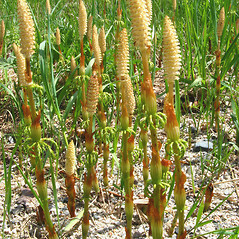- You are here:
- Dichotomous Key
- Equisetaceae
- Equisetum
- Equisetum sylvaticum
Equisetum sylvaticum — wood horsetail
Copyright: various copyright holders. To reuse an image, please click it to see who you will need to contact.
Facts
Wood horsetail's slender, delicate branches have a distinctive lacy appearance. Its below-ground portions can survive repeated fires, and its spores can colonize recently burned areas.
Habitat
Forest edges, forests, swamps
New England distribution
Adapted from BONAP data
Native: indigenous.
Non-native: introduced (intentionally or unintentionally); has become naturalized.
County documented: documented to exist in the county by evidence (herbarium specimen, photograph). Also covers those considered historical (not seen in 20 years).
State documented: documented to exist in the state, but not documented to a county within the state. Also covers those considered historical (not seen in 20 years).
Note: when native and non-native populations both exist in a county, only native status is shown on the map.
Found this plant? Take a photo and post a sighting.
Characteristics
- Habitat
-
- terrestrial
- wetlands
- New England state
-
- Connecticut
- Maine
- Massachusetts
- New Hampshire
- Rhode Island
- Vermont
- Stem form
- the stem is relatively straight
- Branches
- there are branches off the main stem, and these branches are also branched
- Cone tip shape
- The tip of the spore cone is blunt
- Sheathes on older stems
- the leaf sheathes persist in older stems
- Sheath color
- the leaf sheath is mainly red-brown
- Stem cross-section
- up to half of the stem diameter is occupied by the hollow central cavity
- Number of stem ridges
- 8–18
- Stem color
- the aerial stem color is green
- Sheath border color
- the border of the leaf sheath is dark, or with a narrow white edge
- Length of branch section
- the first internode of the branch is equal to or longer than the associated stem sheath
-
Leaves
- Leaf length
- 3–10 mm
- Leaves per node
- 8–18
- Sheath border color
- the border of the leaf sheath is dark, or with a narrow white edge
- Sheath color
- the leaf sheath is mainly red-brown
- Sheathes on older stems
- the leaf sheathes persist in older stems
-
Place
- Habitat
-
- terrestrial
- wetlands
- New England state
-
- Connecticut
- Maine
- Massachusetts
- New Hampshire
- Rhode Island
- Vermont
- Specific habitat
-
- edges of forests
- forests
- swamps
-
Spores or spore cones
- Cone length
- 15–30 mm
- Cone tip shape
- The tip of the spore cone is blunt
- Spore form
- the spores are green and spherical
-
Stem, shoot, branch
- Branch grooves
- the interior of the grrove is C-shaped
- Branches
- there are branches off the main stem, and these branches are also branched
- How hollow is stem
- 17–33
- Length of branch section
- the first internode of the branch is equal to or longer than the associated stem sheath
- Number of stem ridges
- 8–18
- Plant height
- 250–700 mm
- Stem cavities
- 12
- Stem color
- the aerial stem color is green
- Stem cross-section
- up to half of the stem diameter is occupied by the hollow central cavity
- Stem differences
- the vegetative and reproductive stems differ in appearance
- Stem form
- the stem is relatively straight
- Stem texture
- the stem feels smooth or slightly rough
- Stem thickness
- 1.5–3 mm
Wetland status
Usually occurs in wetlands, but occasionally in non-wetlands. (Wetland indicator code: FACW)
In New England
Distribution
- Connecticut
- present
- Maine
- present
- Massachusetts
- present
- New Hampshire
- present
- Rhode Island
- present
- Vermont
- present
Conservation status
Exact status definitions can vary from state to state. For details, please check with your state.
- Massachusetts
- unranked (S-rank: SNR)
- Rhode Island
- rare (S-rank: S2), concern (code: C)
From Flora Novae Angliae dichotomous key
7. Equisetum sylvaticum L. N
wood horsetail. Equisetum sylvaticum L. var. multiramosum (Fern.) Wherry • CT, MA, ME, NH, RI, VT; nearly throughout, lacking from the Cape Cod region of MA. Mesic and hydric forests and forest edges.
Native to North America?
Yes
Synonyms
- Equisetum sylvaticum var. multiramosum (Fern.) Wherry


![Leaves and nodes: Equisetum sylvaticum. ~ By Arthur Haines. ~ Copyright © 2025 Arthur Haines. ~ arthur.d.haines[at]gmail.com](https://newfs.s3.amazonaws.com/taxon-images-239x239/Equisetaceae/equisetum-sylvaticum-ln-ahaines-c.jpg)
![Plant form: Equisetum sylvaticum. ~ By Arthur Haines. ~ Copyright © 2025 Arthur Haines. ~ arthur.d.haines[at]gmail.com](https://newfs.s3.amazonaws.com/taxon-images-239x239/Equisetaceae/equisetum-sylvaticum-ha-ahaines-d.jpg)
![Comparison: Equisetum sylvaticum. ~ By Arthur Haines. ~ Copyright © 2025 Arthur Haines. ~ arthur.d.haines[at]gmail.com](https://newfs.s3.amazonaws.com/taxon-images-239x239/Equisetaceae/equisetum-sylvaticum-equisetum-variegatum-co-ahaines.jpg)

![Spore cones: Equisetum sylvaticum. ~ By Arthur Haines. ~ Copyright © 2025 Arthur Haines. ~ arthur.d.haines[at]gmail.com](https://newfs.s3.amazonaws.com/taxon-images-239x239/Equisetaceae/equisetum-sylvaticum-sc-ahaines-a.jpg)




![Plant form: Equisetum sylvaticum. ~ By Arthur Haines. ~ Copyright © 2025 Arthur Haines. ~ arthur.d.haines[at]gmail.com](https://newfs.s3.amazonaws.com/taxon-images-239x239/Equisetaceae/equisetum-sylvaticum-ha-ahaines-b.jpg)
![Stem cross-section: Equisetum sylvaticum. ~ By Louis-M. Landry. ~ Copyright © 2025 Louis-M. Landry. ~ LM.Landry[at]videotron.ca ~ CalPhotos - calphotos.berkeley.edu/flora/](https://newfs.s3.amazonaws.com/taxon-images-239x239/Equisetaceae/equisetum-sylvaticum-st-llandry.jpg)
